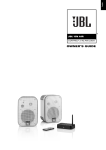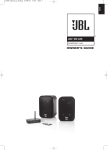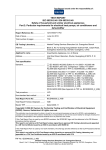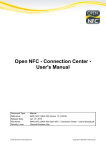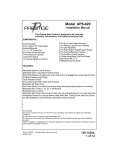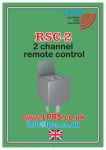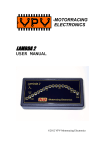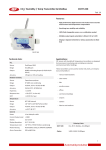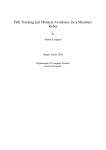Download Technical Data Sheet
Transcript
RSC-2 2 channel remote control www.LPRS.co.uk [email protected] 1 RSC-2 2 Channel Remote Control Designed to work with Keeloq Update documents 2010-02-11 version 1.5 Operating Manual & Application Notes This is a booklet in pdf version to put on to www page Before starting work, please read carefully the attached installation and configuration instructions. We remind you that ignoring the principles and observations contained in the instructions could damage the device. Suggested order of work: ? Check the power supply voltage; the battery attached to the RSC-2 has the appropriate parameters. ? Connect the cable to the Vss Ground (86) pin of the RSC-2 device. ? Connect the second power supply line Vcc + (85) pin to the second pole of the power. ? Connect the same wire to Vss Ground of the device ? Next you can connect outputs: 30 and 87 to the input of controlled device. VERY IMPORTANT Never connect the output of any channel when the RSC-2 does not have appropriate power supply connected. If you want to connect or disconnect any other device to / from the controlled device or control (master and slave) disconnect the power from both devices first. Never connect the output channel when controller for the RSC-2 channel is lower than the voltage of the power-VCC (86) pin. You can get around this problem by using an additional relay or diode corresponding voltage and current. At the end the channel must be connected to the load control channel. If your device has a receiver superregenerative it is recommended that the next assembly is a minimum of 3 m from the first one. The superheterodyne receiver do not have this problem. Device with the superheterodyne receiver is marked differently. You have to always remember that outputs: 30 and 87 ( see the bottom of RSC-2) have Power Transistors MOSFET N-channel which have breakdown diode inside which works with inductive elements. We recommend to apply breakdown diode outside between channel output (Anode) and +VCC supply (Katode) The RSC-2 is adapted for mounting vertically (outputs down) so that water can’t damage the electronics of the device. Standard cover unit is not a fully hermetic. You must not submerge it in water. The device is designed for outdoor use and it is resistant to light flooding. Devices which we have manufactured are resistant to light water immersion and work in the engine compartment and in difficult conditions of moisture. You must not solder wires directly to the output female TERMINALS. This can cause solder out terminals from the board and the RSC-2 can be damaged. For connections you should use female TERMINALS. Operating Manual RSC-2 LPRS (version for web exclusively)11-02-2010R 2 www.LPRS.co.uk Email. [email protected] Power sockets which can be use with the RSC-2. Links to manufacturers and distributors website: Links to manufacturers and distributors website: www.skyrelays.com Model: Uc3001 Uc3003 Cs3770 (Recommended) Power sockets which can be use with the RSC-2. Links to manufacturers and distributors website: www.huaguan-relays.com Automotive relay socket Model: NVF4-S1 NVF4-S2 NVF4-S3 (Recommended) NVF4-S5 www.nteinc.com Model: R95-160 www.customconnector.com Model: BR05-FW5 BR05-WH5 BR05-WHF PR04-WH www.mcmelectronics.com Model: PC Board Mount Socket 40A Relay 12VDC SPDT 5 pin Operating Manual RSC-2 LPRS (version for web exclusively)11-02-2010R 3 www.LPRS.co.uk Email. [email protected] We offer RSC-2 version with wires instead of male terminals The 15 cm wire outside the casing tube is the antenna. This cable should not be shortened. It should be left loose in order to have a good antenna factor to gain energy from the fob. All equipment RSC-2 outputs are giving ground to the active channel. If the channel is turned off the output channel is high impedance as if nothing was connected. Numbers at the bottom of the RSC-2: Number (86): GND supply (-) Number (85) positive supply (+) Number (87) output 1st channel Number (30) output 2nd channel Guarantees are not subject to: v v v v v v v v Cause unit RSC-2 Batteries for fobs Bundles and bundles of wires attached to the device. In the case of loss or destruction of the warranty card, duplicates will not be issued For damage resulting from damage to the automatic device, random events, actions of third parties or improper installation LPRS Ltd accepts no material liability. Properly fill out all points of the guarantee. Original signature of the customer is required when dealing with complaints and repair within the warranty. Flooded equipment is not repaired The decision about the warranty made by LPRS Ltd is final. Operating Manual RSC-2 LPRS (version for web exclusively)11-02-2010R 4 www.LPRS.co.uk Email. [email protected] LPRS Ltd declare that the product is designed and constructed in accordance with: Compliance with the requirements of the standard ETS 300 220-3 9/2009 and article 3 of the Directive 1999/5/EC At the same time we ensure our customers that the devices have been designed and manufactured with great attention to detail and maximising the performance. In this device we apply the latest technology to make sure the device will work perfectly. Please have a look at the diagrams below. Self-Protected Intelligent Power Switches Intelligent Power Switches (IPS) from International Rectifier integrate into a single package a low RDS(on) output HEXFET® power MOSFET with protection and control circuits, making them the most rugged, efficient and compact devices available for automotive loads in harsh environments. The embedded charge pump makes the interface to the micro-controller very simple with full logic-level compatibility. Built-in protection features, like over-temperature, over-current and active inductive energy clamp protect against short circuits, stalled motors and excessive ambient temperature. Designed to safely handle ordinary overload conditions as well as several extraordinary conditions, including loss of ground, load dump and reverse battery, IPS devices eliminate switch failures with the best efficiency and no addition in part count. Designs for low occurrence situations are minimised. The double level shifter circuitry that drives the MOSFET in the HighSide Switcher (HSS) provides immunity from large offsets between the logic ground and the load ground and short switching times. Internal slew rate control for turn-on/off and the use of a low noise charge pump means lower EMI. Ground noise generation of less than 10mA is the industry’s lowest figure. Applications v v v v v v v v v v Ideal replacement for electro-mechanical relays Automotive Transmission Controls Junction Boxes Electronic Stability Controls Anti-lock Brakes, Traction Controls Diesel and Gas Direct Injection Pump Motors, Radiator Fans Head Diesel Glow Plugs Lamps Connection example Vcc+ (Power) 9-30V/DC Channel loading Fuse 1A 85 Output channel -1 87 30 Drain Drain electronics supply Controller RSC-2 Output channel -2 Gate Gate Source Source 86 Vss (Power/Ground) Operating Manual RSC-2 LPRS (version for web exclusively)11-02-2010R 5 www.LPRS.co.uk Email. [email protected] This is correct connection. Current supply is lower than control voltage. Vcc+ (Power) 12V Vcc+ (Power) 24V Loading (bulb) Fuse 1A Output 30 Channel - 1 Drain 85 Electronics Supply Channels 1 and 2 are similar so connections principles are the same. Gate Controller RSC-2 Source 86 Vss (Power/Ground) This is correct connection. Current supply is higher than control voltage. Vcc+ (Power) 12V Vcc+ (Power) 24V Loading (bulb) Fuse 1A 85 Output Channel -1 30 Drain Channels 1 and 2 are similar so connections principles are the same. Electronics Gate Supply Controller RSC-2 Source 86 Vss (Power/Ground) Operating Manual RSC-2 LPRS (version for web exclusively)11-02-2010R 6 www.LPRS.co.uk Email. [email protected] Do not connect in this way Connection causes loss of control of device Power MOSFET, failure because of exeeded max current value for breakdown diode. Vcc+ 9-30V/DC Loading (bulb) Fuse 1A 85 Output channel -1 86 Red colour marks passage of current in case of bad connection Source Gate Electronics Supply Controller RSC-2 Drain 30 Vss (Power/Ground) This wrong connection is often made by users. It causes a transistor Power MOSFET and RSC-2 device failure. Vcc+ 9-30V/DC Fuse 1A 85 Output (Channel-1) 86 Red colour marks passage of current in case of bad connection Source Electronics supply Controller RSC-2 Please pay attention that connection is inversed 180,0 degree. This connection is not allowed. Gate Drain 30 Vss (Power/Ground) Operating Manual RSC-2 LPRS (version for web exclusively)11-02-2010R 7 www.LPRS.co.uk Email. [email protected] Dear Customer! Before using RSC-2 remote control system, we ask you to become acquainted with the content of this manual. Acquired knowledge of operation and functions of the purchased RSC-2 remote control system will ensure proper functioning of the controller. With our compliments, LPRS Ltd. This is a copy "Operating Manual " of the paper 1 Manual is to help connect and configure the device to the new user. This is an universal instruction for all types of RSC-2 devices both 12VDC and 24VDC versions. It clarifies and draws attention to the basic problems with setup, installation and use of the controller. It does not take into account all kinds of connections, possible situations, applications, versions of the client's needs, etc. If you are in doubt please contact the reseller. In some photos the buttons are in yellow. This is done only for contrasting purposes. However we do also offer fobs with yellow buttons. Set may not include minor adjustments necessary to maintain the quality of the product for example colours: remote control cover, remote controller buttons, LEDs, chain types, packages, parameters of the output buffer. We currently offer several versions of the devices with different technical changes, or colours. If you are ordering from our local distributor please include the parameters of interest on your order. Please visit www.lprs.co.uk/RSC-2 for more details: extensive technical documentation 2 including sample applications, recommendations of new devices. Table of contents: User manual Glossary of basic terms ................................. 4 Primary functions .......................................... 6 Versions of the RSC-2 controller ................... 7 Types of key fob transmitters ......................... 8 Functions of the key fob buttons - RSC-2d..... 10 Functions of the key fob buttons - RSC-2e..... 11 Functions of the key fob buttons - RSC-2f...... 12 Description of RSC-2 controller outputs......... 13 Fitting the RSC-2 controller ........................... 14 Example fitting - support ............................... 15 Service manual K-2 Programmer .................................... Operation of the K-2 programmer .......... Configuration of the RSC-2 controller - Logging the key fob transmitters ..... - Bistable mode setting....................... - Monostable mode setting................. - Time recording................................. Basic technical data ............................... Terms of warranty .................................. Repairs .................................................. Variants and ordering information.......... 17 18 19 19 20 21 22 24 25 29 31 3 Glossary of basic terms: BISTABLE MODE: Each press of the key fob transmitter push-button changes the output to the opposite (switches the negative power supply on or off). BISTABLE DEPENDENT MODE: Each press of the key fob transmitter push-button switches on the negative power supply for selected channel with a simultaneous switch-off of the negative power supply for another channel. MONOSTABLE MODE: Each press of the key fob transmitter push-button switches on the negative power supply for selected channel at a previously programmed time. 4 Operating Manual RSC-2 LPRS (version for web exclusively)11-02-2010R 8 www.LPRS.co.uk Email. [email protected] MONOSTABLE DEPENDENT MODE Pressing the key fob transmitter push-button switches on the negative power supply for selected channel at a previously programmed time, with a simultaneous switch-off of the negative power supply for another channel if it was on at that time. DYNAMIC CODE HOPPING "Keeloq®” Keeloq is a software data encoding system derived by Microchip Technology Inc., used for safe and confidential transmission of controlling messages from the key fob transmitter to the controller. The program contained in the key fob transmitter encrypts the data to prevent attempts of scanning and possible use of the information later. It ensures safety of data transmission in relation to other users of the same system. The encryption system is resistant to random and sabotage signals coming from other broadcasting devices, which are jammed at the radio reception stage. PROGRAMMING This function allows the user to modify controller settings 5 This is a copy "Operating Manual " of the paper Primary functions of RSC-2 1. Keeloq dynamic code hopping technology made by Microchip Technology Inc. 2. Two channels working in either independent mode (RSC-2e) or dependent mode (RSC-2d and RSC-2f). 3. Saving operating conditions of channels, configuration and logged key fob transmitters in EEPROM memory after disconnecting the power supply (up to 10 years). 4. Simple and convenient system configuration using a K-2 programmer. 5. Possibility to set a channel into monostable mode with timing adjustable from 0.2 to about 600 seconds. 6. Signalling the registration of the last (6th) key fob transmitter in EEPROM memory. 7. Independent (reset) switch-off of a channel/channels using a 3-button key fob transmitter (e.g. Banan). 8. Channel outputs with overcharging and thermal protection. 9. Possibility to connect inductive devices, e.g. relays. 10. Controlling the negative power supply (open collector output). 6 Versions of the RSC-2 controller RSC-2d - remote controller with two dependent channels. Press the Main push-button of the key fob transmitter to switch on the negative power supply on channel 1 (simultaneously switching off the negative power supply on channel 2 ). Press the Functional push-button of the key fob transmitter to switch on the negative power supply on channel 2 (simultaneously switching off the negative power supply on channel 1). RSC-2e - remote controller with two independent channels. Press the Main push-button of the key fob transmitter to switch on/off the negative power supply on channel 1. Press the Functional push-button of the key fob transmitter to switch on/off the negative power supply on channel 2. RSC-2f - remote controller with two dependent channels. Press the Functional push-button of the key fob transmitter to switch on the negative power supply on channel 1 (simultaneously switching off the negative power supply on channel 2). Press the Assistant push-button of the key fob transmitter to switch on the negative power supply on channel 2 (simultaneously switching off the negative power supply on channel 1). The Main push-button of the key fob transmitter erases the active channel. 7 Key fob transmitter “Alien” a b a 8 Key fob transmitter “Ring” b a a b b Functional Main push-button Operating Manual RSC-2 LPRS (version for web exclusively)11-02-2010R Key fob transmitter “Duet” push-button 9 www.LPRS.co.uk Email. [email protected] Key fob transmitter “Banan” b a c a c Key fob transmitter ”Lider” b d c Assistant a b c push-button Key fob Push-button Main Push-button Functional ALIEN, DUET, RING switches on negative power supply on channel 1 switching off negative power supply on channel 2 switches on negative power supply on channel 2 switching off negative power supply on channel 1 switches on negative power supply on channel 2 switching off negative power supply on channel 1 switches on negative power supply on channel 1 switching off negative power supply on channel 2 switches on negative power supply on channel 1 switching off negative power supply on channel 2 BANAN LIDER, QUARTET 10 d d Assistant 2 push-button This is a copy "Operating Manual " of the paper Key fob transmitter “Quartet” 9 Push-button Push-button Assistant Assistant 2 switches on negative power supply on channel 2 switching off negative power supply on channel 1 - resets active resets resets channel 1 Functions of the key fob buttons working with RSC-2e Key fob Push-button Main ALIEN, DUET, RING BANAN LIDER, QUARTET Push-button Functional switches on /off negative power supply on channel 1 switches on /off negative power supply on channel 1 switches on /off negative power supply on channel 1 Push-button Push-button Assistant Assistant-2 switches on /off negative power supply on channel 2 switches on /off negative power supply on channel 2 switches on /off negative power supply on channel 2 - - resets active channel - resets channel 1 resets channe 2 11 Functions of the key fob buttons working with RSC-2f Key fob Push-button Main Push-button Functional Push-button Assistant BANAN resets active channel switches on negative power supply on channel 1 switching off negative power supply on channel 2 switches on negative power supply on channel 2 switching off negative power supply on channel 1 switches on negative power supply on channel 1 switching off negative power supply on channel 2 switches on negative power supply on channel 2 switching off negative power supply on channel 1 LIDER, resets QUARTET active channel 12 Operating Manual RSC-2 LPRS (version for web exclusively)11-02-2010R 10 www.LPRS.co.uk Email. [email protected] Description of RSC-2 controller outputs Antenna Control outputs: No 30: channel 1 No 87: channel 2. Power inputs : No 85: battery (+) 12V/DC or 24V/DC. No 86: battery minus (ground). Antenna: (do not cut !) The wire antenna should be left free lying or hanging, dependent on the fitting conditions. Do not connect or group with other wires. It has a direct influence on the functioning of the key fob transmitter. RSC-2 viewed from the output side RSC-2 external design Figure 1 Figure 2 This is a copy "Operating Manual " of the paper Fitting the RSC-2 controller Before starting to fit the controller, it is recommended to pay special attention to the proper connection of its power outputs. (+) 13 1 channel 30 86 (-) 85 Connect the power supply to the controller using female connectors inserted onto the output leads. Solder the female connector or tighten the clamps on the wires of the controlled device. It is recommended to follow the connection pattern closely to avoid damaging the controller. 87 2 channel 12V (+) (-) RSC-2 outputs (connection side view) Figure 4 Female connector Figure 3 14 Power support for RSC-2 controllers (Fig.5) can be used for connecting. You must NOT solder the wires to the output leads. Soldering wires can cause controller damage and loss of warranty. RSC-2 controllers have, by standards, male output connector leads, which are powered with 12V/DC or 24V/DC power supply. An example connection diagram is shown on Fig 6 and 7. Power support for RSC-2 controllers Description of the output leads of the support: Red: 0.75mm (coupled wire): +12V/DC or 24V/DC power supply Black with a red strap: 0.75mm (coupled wire): negative power supply. Bulb or relay 1 channel (24V) Bulb or relay 2 channel(24V) Two loose black wires, 1.5mm: outputs for channels 1 and 2. RSC-2 Power support Figure 5 15 30 (+) 86 (-) 85 (+) (-) 87 Bulb 1 (12 V) 24V (+) 16 (-) 12V (+) (-) Bulb 2 (12 V) 1 channel - Bulb 1 2 channel - Bulb 2 12V (+) Example connection diagram: RSC-2 for controlling 24V bulbs Example connection diagram: RSC-2 for controlling 12V bulbs Figure 6 Figure 7 Operating Manual RSC-2 LPRS (version for web exclusively)11-02-2010R 11 (-) www.LPRS.co.uk Email. [email protected] K-2 programmer: A K-2 programmer allows to change current settings of RSC-2 12V/DC or 24V/DC controllers. K-2 acting at range 11V - 13V supply only. By means of this programmer, installer can check the functioning of the controller and change settings to suit user's needs. A schematic diagram of the configuration process is shown below. Position 1: Delete existing key fob transmitters and logg new ones (signalling: LED diode blinks once in 3 seconds) Position 2: Bistable mode setting (signalling: LED diode blinks twice in 3 seconds) Do not connect K-2 programmer to 24V. K-2 programmer Figure 8 ! LED-2 LED-1 Position 3: Monostable mode setting (signalling: LED diode blinks three times in 3 seconds) Position 4: Time registration for monostable mode (signalling: LED diode blinks four times in 3 seconds) This is a copy "Operating Manual " of the paper Do not connect K-2 programmer to 24V. 1 channel - LED 1 2 channel - LED 2 17 Operation of the K-2 programmer When the ! push-button of the K-2 programmer is being pressed, voltage between 0.45V and 0.65V will appear between controller outputs no. 86 and 87. Introducing this requirement protects the RSC-2 controller from accidental entering configuration mode during standard operation of the controller. Connecting the K-2 programmer to the RSC-2 controller To connect the K-2 programmer to the RSC-2 controller: a)- disconnect the power supply from the RSC-2 controller b)- disconnect the RSC-2 controller from the controlled circuit c)- connect the programmer to the RSC-2 controller, according to the numbering of outputs. Before pressing the ! push-button, check if LED-2 diode of the programmer is turned off. LED-2 turned on makes it impossible to configure the RSC-2 controller. IMPORTANT ! To turn off the LED-2 in RSC-2e, press the Functional push-button on the key fob transmitter. To turn off the LED-2 in RSC-2d and RSC-2f, press the Main push-button on the key fob transmitter. While configuring between position 2 and 4, only logged key fob transmitters should be used in the RSC-2 controller. 18 Configuration of the RSC-2 controller: To enter configuration mode: a)- Press and hold the ! push-button of the K-2 programmer until LED-1 diode turns on and a simultaneous sound signal occurs. b)- When LED-1 diode has turned on in the K-2 programmer, release the ! push-button. After entering configuration mode, LED-1 of the K-2 programmer and the buzzer will turn on simultaneously every 3 seconds for 0.5 second, which means that the programmer is at position 1 in the configuration process. Pressing any of the key fob transmitter buttons for the first time will cause Important ! its logging and deleting all key fob transmitters logged so far in the EEPROM memory of the RSC-2 controller. Logging key fob transmitters: position 1 in the configuration process. If you intend to logg a key fob transmitter, press any push-button on the first key fob transmitter and hold it until LED-1 blinks twice and there is a buzzer signal. Such a signalling indicates logging the key fob transmitter in the controller memory. The procedure is the same for the following key fob transmitters. 19 Important ! Up to 6 key fob transmitters can be logged in the controller. While attempting to logg a seventh transmitter, the controller will indicate the end of the process of logging key fob transmitters by a short blink of LED-1 and buzzer 0.5 second once every 1 second. a)- If you wish to exit configuration mode, disconnect power supply from the K-2 programmer for at least 5 seconds b)- If you wish to move to the next,2 position in the configuration process, press the ! pushbutton of the K-2 programmer: LED-1 of the programmer and the buzzer will turn on simultaneously, twice every 3 seconds for 0.5 second. Setting bistable mode: position 2 in configuration process. To set bistable mode for channel 1, press for a short time the Main push-button on the key fob transmitter: double simultaneous signalling by LED-1 and the buzzer informs about setting channel 1 into bistable mode. To set bistable mode for channel 2, press the Functional push-button on the key fob transmitter: double simultaneous signalling by LED-1 and the buzzer informs about setting channel 2 into bistable mode.a)- If you wish to exit the configuration procedure, disconnect the power suply of the K-2 programmer for at 20 least 5 seconds. Operating Manual RSC-2 LPRS (version for web exclusively)11-02-2010R 12 www.LPRS.co.uk Email. [email protected] b)- If you wish to move to the next, 3 position in the configuration process, press the ! push-button of the K-2 programmer for a short time: LED-1 diode of the K-2 programmer and the buzzer will turn on simultaneously, 3 times every 3 seconds for 0.5 second. For RSC-2f version: Channel 1 is assigned as the Functional push-button on the key fob transmitter. Important ! Channel 2 is assigned as the Assistant push-button on the key fob transmitter. Setting monostable mode: position 3 in the configuration procedure. To switch into monostable mode for channel 1, press the Main push-button on the key fob transmitter for a short time: double simultaneous signalling by LED-1 and the buzzer indicates setting channel 1 into monostable mode. To switch into monostable mode for channel 2, press the Functional button on the key fob transmitter for a short time: double simultaneous signalling by LED-1 and the buzzer indicates setting channel 2 into monostable mode. a)- If you wish to exit the configuration procedure, disconnect the power supply of the K-2 programmer for at least 5 seconds b)- If you wish to move to the next, 4 position in the configuration process, press the ! push-button of the K-2 programmer for a short time: LED-1 diode of the K-2 programmer and the buzzer will turn on. 21 simultaneously, 4 times every 3 seconds for 0.5 second. This is a copy "Operating Manual " of the paper Important! For RSC-2f version: Channel 1 is assigned as the Functional push-button on the key fob transmitter. Channel 2 is assigned as the Assistant push-button on the key fob transmitter. Time registration in the monostable mode: position 4 in the configuration procedure To record the time for a selected channel in monostable mode, press the selected push-button on the key fob transmitter - time recording will begin: LED-1 and the buzzer will turn on for the time of recording. Pressing the same push-button on the key fob transmitter again will finish time recording: LED-1 and the buzzer will turn off. Double signalling by LED-1 and the buzzer indicates saving registered time in nonvolatile EEPROM memory. Repeated pressing of the selected key fob transmitter push-button will restart the time registration procedure.In case of time registration for the next channel proceed as described above. a)- If you wish to exit the configuration process, disconnect the power supply of the K-2 programmer for at least 5 seconds. b)- Press the ! push-button of the K-2 programmer for a short time to move to the first position in the 22 configuration. A schematic diagram of moving around the programming procedure is shown on page 17. Exit the configuration procedure To exit the configuration procedure, disconnect the power supply for at least 5 seconds. All changes in the configuration will be saved automatically. Turning on the power supply of the controller or a programmer together with the controller allows you to check the functioning after making changes in the configuration. Important! While checking the operation of the controller, do not press the ! push-button of the programmer. Only key fob transmitters logged in the controller should be used. Factory settings of the controllers RSC-2d, RSC-2e, RSC-2f: Logged two key fob transmitters, monostable mode 1 and 2 channel, time one secod. 23 Basic technical data: Average range of key fob transmitters (measured in open space and at low interference level).......... 30 m, 30% Average A23, l1028 battery type service life........................................................................................ 6 to 12 monts Recommended range of correct operation temperatures.................................................................... -20 to +60°C Supply voltage rating (depends on the RSC-2 version, page 31)........................................................ 9 V to 28 V/DC Data encoding system: Keeloq®, Microchip Technology Inc............................................................ 7,3 x 1019 Data transmission frequency of key fob transmitters.......................................................................... 433.92 MHz 5% Sensitivity of radio receiver (depends on the RSC-2 version, page 31)............................................... -85 dbm, 10% Key fob transmitter average emitting power........................................................................................ max 5 mW, 30% Maximum supply current - open collector, (depends on the RSC-2 version, page 31)...................... Imax 1,7A 24 Operating Manual RSC-2 LPRS (version for web exclusively)11-02-2010R www.LPRS.co.uk Email. [email protected] This is a copy "Operating Manual " of the paper TERMS OF WARRANTY The manufacturer is obliged to repair the device free of charge if, during the warranty period, flaws occur due to the manufacturer’s fault. The warranty is valid 12 months from the date of purchase. The warranty will not be accepted in the following cases: exceeding admissible values of electric current and voltage (included in the manual), operating the device without accordance to the manual, inappropriate fitting and use, making any repairs on one's own, flooding the device with water or any other liquid, tearing or breaking the warranty seal, changing the warranty card, or lacking the document proving the purchase (receipt, invoice). After-warranty service and technical examination of the delivered equipment is chargeable.In the case of complaint, the complete device together with remote controllers and the description of the defect, warranty card, return address and telephone number should be delivered to the point of sale (fitting) first, and in an emergency situation - to the manufacturer. 25 Decision of the LPRS service concerning warranty repairs is final. Warranty does not include: batteries, equipment and remote control casings, and bundles of wires attached to the equipment. In case of loss or damage the warranty card, copies will not be issued. LPRS takes no material or legal liability for losses resulting from automatic damage of the equipment, random accidents, third-party interferences or inappropriate fitting. Filling in all points contained in the warranty and a readable customer's signature, are basic conditions while examining the request for warranty repairs. 26 Disclaimer Low Power Radio Solutions Ltd has an on going policy to improve the performance and reliability of their products; we therefore reserve the right to make changes without notice. The information contained in this data sheet is believed to be accurate however we do not accept any responsibility for errors or any liability arising from the application or use of any product or circuit described herein. This manual neither states nor implies warranty of any kind, including fitness for any particular application. RSC-2 controller is a component part of an end system and should be treated as such. Testing to fitness is the sole responsibility of the manufacturer of the device as is also the deployment into the field. Any liability from defect or malfunction is limited to the replacement of product ONLY, and does not include labour or other incurred corrective expenses. Using or continuing to use these devices hereby binds the user to these terms. For further information and technical assistance pleace contact: Tel: +44 (0) 1993 709418 email: [email protected] 27 Dear customer Thank you for purchasing our device. We are convinced that you will fully appreciate the work we have done in developing and manufacturing the RSC-2 controller. We believe that the equipment meets your functional expectations with it’s high quality performance and reliability. We are open to your comments of the maintenance and operation of the equipment. For further information of the product, please go to: www.lprs.co.uk/RSC-2 Thank you very much for your time. RSC-2 product support department. Operating Manual RSC-2 LPRS (version for web exclusively)11-02-2010R 14 www.LPRS.co.uk Email. [email protected] Date of delivery for repair Date, serviceperson signature Range of repair This is a copy "Operating Manual " of the paper Installation Notes Variants and ordering information RSC2 f 12 s 1,7 Current max (A) Receiver type and frequency s-433,92 MHz, super-reactive h-433,92 MHz, superheterodyne Supply max (V) Software version d-two dependent channels e-two independent channels f-two dependents channels with reset Main device name Fitting date or sale. year Version of controller: RSC-2........ month day 201 Installer’s stamp Installation notes .......................................... Installer Signature I know about using device, present settings of controller and terms of guaranty. 32 LPRS 02022010R Operating Manual RSC-2 LPRS (version for web exclusively)11-02-2010R .......................................... date and customer signature 15 www.LPRS.co.uk Email. [email protected]
















